
|
Now it is 11.5 mag (Mar. 12, Carlos Labordena). It stays bright as 11 mag for a long time. In the Southern Hemisphere, it will be unobservable soon. In the Northern Hemispehre, it stays observable for a long time until the comet fades out. But it will be getting lower gradually after this.
Date(TT) R.A. (2000) Decl. Delta r Elong. m1 Best Time(A, h)
Mar. 17 4 13.53 34 2.4 2.798 2.664 72 10.8 19:32 (102, 54)
Mar. 24 4 20.27 35 36.8 2.874 2.649 67 10.9 19:39 (106, 49)
|
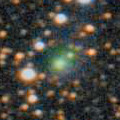
|
Now it is bright as 11.0 mag (Feb. 21, Juan Jose Gonzalez). It is expected to brighten up to 9 mag in summer. In the Southern Hemisphere, it stays observable in good condition for a long time until the comet will fade out. In the Northern Hemisphere, it is observable only until June.
Date(TT) R.A. (2000) Decl. Delta r Elong. m1 Best Time(A, h)
Mar. 17 19 25.85 -0 39.7 3.032 2.762 64 11.8 4:44 (299, 34)
Mar. 24 19 30.49 -1 33.4 2.887 2.716 70 11.6 4:34 (303, 36)
|
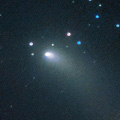
|
It brightened up to 9-10 mag from December to February. Now it is fading very rapidly. It has already faded down to 16.4 mag (Mar. 15, Jean-Francois Soulier). In the Northern Hemisphere, it stays extremely low after this. In the Southern Hemisphere, it will be getting higher in the morning sky after this, then it stays observable in good condition.
Date(TT) R.A. (2000) Decl. Delta r Elong. m1 Best Time(A, h)
Mar. 17 21 41.76 -0 54.9 1.433 0.773 30 11.8 4:44 (276, 8)
Mar. 24 21 46.96 -5 37.7 1.441 0.875 36 12.3 4:34 (282, 7)
|
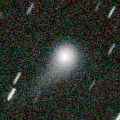
|
Now it is 12.7 mag (Mar. 12, Seiichi Yoshida). It stays 12 mag for a long time until spring in 2019. In the Northern Hemisphere, it stays observable in good condition while the comet will be brightening gradually. In the Southern Hemisphere, it is not observable until September.
Date(TT) R.A. (2000) Decl. Delta r Elong. m1 Best Time(A, h)
Mar. 17 10 50.04 80 9.9 2.605 2.962 101 12.2 23:03 (180, 45)
Mar. 24 9 29.52 78 3.9 2.624 2.932 97 12.1 21:19 (180, 47)
|
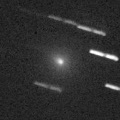
|
Now it is 12.5 mag (Mar. 11, Chris Wyatt). It will fade out after this. In the Northern Hemisphere, it stays observable for a long time in the evening sky. In the Southern Hemisphere, it will be getting higher gradually.
Date(TT) R.A. (2000) Decl. Delta r Elong. m1 Best Time(A, h)
Mar. 17 3 19.35 8 2.4 1.425 1.166 54 12.6 19:32 ( 77, 31)
Mar. 24 3 50.76 9 16.1 1.480 1.224 55 13.2 19:39 ( 79, 31)
|
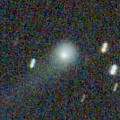
|
Now it is very bright as 12.8 mag (Mar. 12, Seiichi Yoshida). It will be observable at 12-13 mag for a long time from 2017 to 2018. In the Southern Hemisphere, it will be hardly observable after this.
Date(TT) R.A. (2000) Decl. Delta r Elong. m1 Best Time(A, h)
Mar. 17 16 5.37 45 27.1 3.301 3.737 108 12.9 4:28 (180, 80)
Mar. 24 15 52.52 48 7.5 3.261 3.741 111 12.9 3:48 (180, 77)
|

|
It is not observable now. It will appear in the morning sky in late March in the Southern Hemisphere, or in late April in the Northern Hemisphere.
Date(TT) R.A. (2000) Decl. Delta r Elong. m1 Best Time(A, h)
Mar. 17 22 31.51 -6 2.2 6.722 5.790 19 13.9 4:44 (273, -6)
Mar. 24 22 36.60 -5 26.4 6.682 5.790 24 13.8 4:34 (275, -3)
|

|
It brightened up to 9.2 mag from November to December (Nov. 16, Juan Jose Gonzalez). Now it is fading rapidly. It has already faded down to 16.1 mag (Mar. 11, Toshihiko Ikemura, Hirohisa Sato). It stays observable in good condition until summer when it fades out.
Date(TT) R.A. (2000) Decl. Delta r Elong. m1 Best Time(A, h)
Mar. 17 14 28.17 3 57.0 1.025 1.894 139 13.9 2:52 ( 0, 59)
Mar. 24 14 23.20 4 30.6 1.030 1.941 146 14.2 2:19 ( 0, 59)
|

|
It brightened up to 7.1 mag from May to June in 2017 (June 21, Juan Jose Gonzalez). Now it is fading. It has already faded down to 12.9 mag (Jan. 17, Chris Wyatt). In the Southern Hemisphere, it stays observable for a long time after this. However, it will be extremely low from January to March. It will never be observable again in the Northern Hemisphere.
Date(TT) R.A. (2000) Decl. Delta r Elong. m1 Best Time(A, h)
Mar. 17 23 49.17 -45 51.0 4.379 3.732 44 14.4 19:32 ( 56,-38)
Mar. 24 0 1.18 -45 12.6 4.416 3.798 46 14.4 4:34 (304,-38)
|
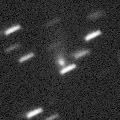
|
Now it is 15.6 mag (Feb. 18, Yuji Ohshima). It will brighten up to 9 mag in summer. However, it is hardly observable when it is bright. In the Northern Hemisphere, it is observable only until March when it brightens up to 14 mag. In the Southern Hemisphere, it is observable from July to September, but it locates in extremely low.
Date(TT) R.A. (2000) Decl. Delta r Elong. m1 Best Time(A, h)
Mar. 17 1 2.81 37 49.0 2.822 2.205 43 14.7 19:32 (123, 19)
Mar. 24 1 16.71 36 31.3 2.802 2.114 38 14.5 19:39 (124, 15)
|

|
Now it is 13.8 mag (Feb. 10, Chris Wyatt). It will be getting lower gradually after this in the evening sky. It will be unobservable in May.
Date(TT) R.A. (2000) Decl. Delta r Elong. m1 Best Time(A, h)
Mar. 17 3 25.82 2 32.3 2.597 2.187 55 14.5 19:32 ( 72, 29)
Mar. 24 3 36.41 5 34.0 2.703 2.221 51 14.7 19:39 ( 78, 26)
|
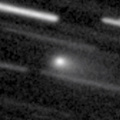
|
Now it is 16.0 mag (Mar. 14, Jean-Francois Soulier). It will be observable at 14 mag in good condition from spring to summer.
Date(TT) R.A. (2000) Decl. Delta r Elong. m1 Best Time(A, h)
Mar. 17 19 31.51 -28 53.2 1.811 1.678 66 14.8 4:44 (319, 12)
Mar. 24 19 53.33 -27 53.6 1.748 1.661 68 14.6 4:34 (317, 12)
|
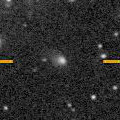
|
Now it is 16.3 mag (Feb. 18, Toshihiko Ikemura, Hirohisa Sato). It is expected to brighten up to 13-14 mag from 2018 to 2019. In the Northern Hemisphere, it stays observable in good condition for a long time. In the Southern Hemisphere, it locates extremely low until summer.
Date(TT) R.A. (2000) Decl. Delta r Elong. m1 Best Time(A, h)
Mar. 17 19 39.13 40 10.3 4.567 4.326 69 15.7 4:44 (247, 51)
Mar. 24 19 39.68 40 46.4 4.476 4.285 72 15.6 4:34 (247, 54)
|

|
Now it is 16.4 mag (Feb. 21, B. Lutkenhoner, K. Dankov). It stays 15 mag from 2018 to 2019, and it will be observable for a long time in the Southern Hemisphere. In the Northern Hemisphere, it will never be observable again.
Date(TT) R.A. (2000) Decl. Delta r Elong. m1 Best Time(A, h)
Mar. 17 14 0.40 -62 55.2 4.347 4.791 110 15.7 2:24 ( 0, -8)
Mar. 24 13 53.52 -64 10.9 4.260 4.758 114 15.6 1:50 ( 0, -9)
|
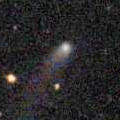
|
Now it is 16.2 mag (Mar. 11, Toshihiko Ikemura, Hirohisa Sato). It stays 16 mag for a long time from 2017 to 2018. It is observable in excellent condition in the Northern Hemisphere. It locates very low in the Southern Hemisphere.
Date(TT) R.A. (2000) Decl. Delta r Elong. m1 Best Time(A, h)
Mar. 17 7 18.15 43 36.6 5.009 5.395 107 15.7 19:39 (180, 81)
Mar. 24 7 13.64 43 54.1 5.135 5.403 100 15.7 19:39 (148, 79)
|

|
It brightened up to 8.1 mag in autumn (Oct. 3, Juan Jose Gonzalez). Now it is fading rapidly. It has already faded down to 17.9 mag (Mar. 11, Toshihiko Ikemura, Hirohisa Sato). In the Northern Hemisphere, it stays observable in good condition for a long time. In the Southern Hemisphere, it will never be observable again after this.
Date(TT) R.A. (2000) Decl. Delta r Elong. m1 Best Time(A, h)
Mar. 17 7 13.93 70 1.4 2.168 2.521 98 15.8 19:37 (180, 55)
Mar. 24 7 30.84 67 48.2 2.283 2.589 96 16.1 19:39 (178, 57)
|
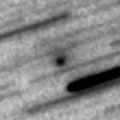
|
Now it is 17.6 mag (Feb. 18, Martin Masek). It will brighten rapidly after this, and will brighten up to 12 mag from April to June. In the Southern Hemisphere, it stays observable in excellent condition. In the Northern Hemisphere, it will be unobservable from April to June when the comet becomes brightest.
Date(TT) R.A. (2000) Decl. Delta r Elong. m1 Best Time(A, h)
Mar. 17 17 52.47 -34 0.7 1.209 1.535 87 16.2 4:44 (340, 18)
Mar. 24 18 22.90 -36 0.4 1.134 1.488 88 15.9 4:34 (338, 15)
|
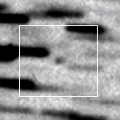
|
Now it is 17.3 mag (Feb. 23, Toshihiko Ikemura, Hirohisa Sato). It will brighten rapidly after this, and it will brighten up to 11 mag from summer to autumn. It is observable in excellent condition in the Southern Hemisphere. It locates somewhat low in the Northern Hemisphere.
Date(TT) R.A. (2000) Decl. Delta r Elong. m1 Best Time(A, h)
Mar. 17 19 40.25 -17 50.6 2.594 2.306 62 16.2 4:44 (310, 19)
Mar. 24 19 53.85 -17 34.0 2.497 2.282 66 15.9 4:34 (310, 20)
|

|
Now it is 15.6 mag (Feb. 26, Alexander Baransky). It will be fading slowly until summer.
Date(TT) R.A. (2000) Decl. Delta r Elong. m1 Best Time(A, h)
Mar. 17 11 39.65 12 13.3 2.558 3.541 169 15.9 0:04 ( 0, 67)
Mar. 24 11 35.27 12 36.7 2.575 3.542 163 15.9 23:27 ( 0, 68)
|

|
Appearing in the morning sky in the Southern Hemisphere. It is observable at 15 mag in good condition in 2018. It is not observable until May in the Northern Hemisphere.
Date(TT) R.A. (2000) Decl. Delta r Elong. m1 Best Time(A, h)
Mar. 17 21 37.11 -21 20.4 3.740 3.006 37 15.9 4:44 (294, -4)
Mar. 24 21 47.88 -20 39.3 3.691 3.015 41 15.9 4:34 (294, -2)
|
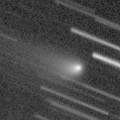
|
Appearing in the morning sky. It is fading now. But it stays 16 mag until summer.
Date(TT) R.A. (2000) Decl. Delta r Elong. m1 Best Time(A, h)
Mar. 17 19 20.96 -22 30.8 3.660 3.405 67 16.0 4:44 (316, 18)
Mar. 24 19 17.94 -22 57.4 3.564 3.447 75 16.0 4:34 (321, 21)
|

|
It will brighten up to 16 mag in spring. In the Southern Hemisphere, it stays observable until August, but it will be unobservable after that. In the Northern Hemisphere, it stays unobservable until June, but it will be observable in good condition after that.
Date(TT) R.A. (2000) Decl. Delta r Elong. m1 Best Time(A, h)
Mar. 17 20 55.90 -44 1.0 1.679 1.405 56 16.3 4:44 (317,-11)
Mar. 24 21 29.18 -41 34.6 1.638 1.366 56 16.3 4:34 (313,-11)
|

|
It brightened up to 9.7 mag in November (Nov. 16, Juan Jose Gonzalez). Now it is fading rapidly. It has already faded down to 15.9 mag (Mar. 13, Toshihiko Ikemura, Hirohisa Sato).
Date(TT) R.A. (2000) Decl. Delta r Elong. m1 Best Time(A, h)
Mar. 17 16 49.08 -12 27.7 1.403 1.900 103 16.3 4:44 (351, 42)
Mar. 24 16 51.25 -12 40.8 1.382 1.959 109 16.7 4:34 (356, 42)
|

|
Now it is 16.2 mag (Mar. 12, Toshihiko Ikemura, Hirohisa Sato). It will be fading slowly after this.
Date(TT) R.A. (2000) Decl. Delta r Elong. m1 Best Time(A, h)
Mar. 17 10 21.36 7 14.5 8.682 9.613 158 16.5 22:41 ( 0, 62)
Mar. 24 10 20.11 7 33.7 8.734 9.618 150 16.5 22:13 ( 0, 62)
|
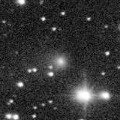
|
Now it is 16.4 mag (Mar. 14, Toshihiko Ikemura, Hirohisa Sato). It will be fading after this. In the Northern Hemisphere, it stays observable in the northern sky for a long time. It is not observable at all after this in the Southern Hemisphere.
Date(TT) R.A. (2000) Decl. Delta r Elong. m1 Best Time(A, h)
Mar. 17 21 59.51 77 16.0 3.669 3.634 80 16.6 4:44 (196, 35)
Mar. 24 22 19.60 79 26.0 3.714 3.665 79 16.7 4:34 (193, 35)
|
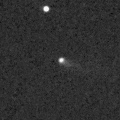
|
It brightened up to 15.7 mag in February (Feb. 11, Catalina Sky Survey). Now it is fading rapidly. It has already faded down to 16.5 mag (Mar. 11, Toshihiko Ikemura, Hirohisa Sato). It will be fainter than 18 mag in late April.
Date(TT) R.A. (2000) Decl. Delta r Elong. m1 Best Time(A, h)
Mar. 17 13 25.73 24 29.7 0.470 1.411 146 16.9 1:49 ( 0, 79)
Mar. 24 13 25.07 23 47.8 0.484 1.434 149 17.0 1:21 ( 0, 79)
|

|
It has passed the perihelion on Feb. 10, and it approached to the Sun down to 0.1 a.u. But it has not been observed in this apparition yet. It has been lost since the discovery in 2011. It is expected to be observable at 17 mag in good condition in March.
Date(TT) R.A. (2000) Decl. Delta r Elong. m1 Best Time(A, h)
Mar. 17 16 49.29 -45 43.2 0.107 1.017 98 17.5 4:44 (353, 9)
Mar. 24 12 16.84 -18 43.2 0.160 1.150 162 16.9 0:19 ( 0, 35)
|

|
Now it is 16.5 mag (Mar. 12, Toshihiko Ikemura, Hirohisa Sato). It has not been brightening well since the discovery in 2010. It is observable in good conditioin in the Northern Hemisphere. It is not observable for a long time in the Southern Hemisphere.
Date(TT) R.A. (2000) Decl. Delta r Elong. m1 Best Time(A, h)
Mar. 17 5 44.41 74 16.6 8.608 8.690 91 16.9 19:32 (171, 49)
Mar. 24 5 48.99 73 53.2 8.670 8.680 87 16.9 19:39 (168, 49)
|

|
Now it is 16.1 mag (Feb. 18, Toshihiko Ikemura, Hirohisa Sato). It will be fading gradually after this, and it will be fainter than 18 mag in autumn. In the Northern Hemisphere, it stays observable in good condition for a long time. In the Southern Hemisphere, it will never be observable again.
Date(TT) R.A. (2000) Decl. Delta r Elong. m1 Best Time(A, h)
Mar. 17 21 42.43 63 13.7 7.289 6.990 68 16.9 4:44 (213, 35)
Mar. 24 21 53.19 63 53.6 7.331 7.011 67 16.9 4:34 (212, 36)
|

|
Now it is 17.3 mag (Mar. 12, Toshihiko Ikemura, Hirohisa Sato). It will be fading after this, and it will be fainter than 18 mag in July.
Date(TT) R.A. (2000) Decl. Delta r Elong. m1 Best Time(A, h)
Mar. 17 12 13.28 18 30.2 4.602 5.556 161 16.9 0:37 ( 0, 73)
Mar. 24 12 6.67 19 54.3 4.638 5.579 158 16.9 0:03 ( 0, 75)
|

|
Now it is 16.8 mag (Mar. 12, Toshihiko Ikemura, Hirohisa Sato). It will brighten up to 15 mag in January, 2019. It stays observable in excellent condition in the Northern Hemispehre. It is observable only until June in the Southern Hemisphere.
Date(TT) R.A. (2000) Decl. Delta r Elong. m1 Best Time(A, h)
Mar. 17 12 5.87 24 22.2 3.368 4.300 156 17.0 0:30 ( 0, 79)
Mar. 24 11 54.92 26 16.4 3.353 4.260 152 16.9 23:46 ( 0, 81)
|

|
Now it is 16.8 mag (Mar. 15, iTelescope Observatory, Siding Spring). In the Southern Hemisphere, it is observable at 17 mag in good condition. It will be too low to observe in June. In the Northern Hemisphere, it locates extremely low only in spring.
Date(TT) R.A. (2000) Decl. Delta r Elong. m1 Best Time(A, h)
Mar. 17 4 47.75 -41 12.7 2.749 2.724 78 17.0 19:32 ( 26, 7)
Mar. 24 5 0.23 -38 13.7 2.763 2.717 76 17.0 19:39 ( 32, 8)
|
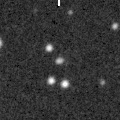
|
Now it is 17.0 mag (Mar. 13, Toshihiko Ikemura, Hirohisa Sato). It is observable at 17 mag in good condition in spring.
Date(TT) R.A. (2000) Decl. Delta r Elong. m1 Best Time(A, h)
Mar. 17 13 7.81 -13 40.8 1.622 2.557 154 17.3 1:32 ( 0, 41)
Mar. 24 13 4.69 -13 20.1 1.584 2.551 162 17.1 1:01 ( 0, 42)
|

|
Now it is 18.7 mag (Mar. 14, Toshihiko Ikemura, Hirohisa Sato). It stays observable at 17-18 mag in good condition for a while.
Date(TT) R.A. (2000) Decl. Delta r Elong. m1 Best Time(A, h)
Mar. 17 15 22.57 -6 54.2 1.858 2.564 125 17.2 3:46 ( 0, 48)
Mar. 24 15 21.55 -6 27.4 1.822 2.599 132 17.2 3:17 ( 0, 48)
|
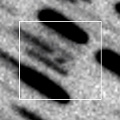
|
Now it is 18.6 mag (Mar. 13, Toshihiko Ikemura, Hirohisa Sato). It will brighten rapidly, and brighten up to 7 mag from August to September. In the Northern Hemisphere, it will be observable in excellent condition. In the Southern Hemisphere, it will be unobservable from July to August. But it will be observable in good condition before and after tha.
Date(TT) R.A. (2000) Decl. Delta r Elong. m1 Best Time(A, h)
Mar. 17 18 32.96 4 26.2 2.360 2.369 78 17.5 4:44 (308, 47)
Mar. 24 18 43.76 6 5.6 2.230 2.309 81 17.2 4:34 (308, 49)
|

|
Now it is 16.4 mag (Mar. 13, Toshihiko Ikemura, Hirohisa Sato). It will be fainter than 18 mag in summer.
Date(TT) R.A. (2000) Decl. Delta r Elong. m1 Best Time(A, h)
Mar. 17 15 3.78 -16 32.9 5.597 6.258 127 17.2 3:27 ( 0, 38)
Mar. 24 15 2.11 -15 44.7 5.524 6.274 135 17.2 2:58 ( 0, 39)
|
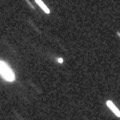
|
Now it is 17.1 mag (Mar. 12, Toshihiko Ikemura, Hirohisa Sato). It will be fading gradually after this.
Date(TT) R.A. (2000) Decl. Delta r Elong. m1 Best Time(A, h)
Mar. 17 11 9.01 39 57.4 7.366 8.160 140 17.3 23:29 (180, 85)
Mar. 24 11 3.66 39 43.6 7.431 8.180 136 17.3 22:56 (180, 85)
|

|
Now it is 17.8 mag (Mar. 11, Toshihiko Ikemura, Hirohisa Sato). It stays observable at 18 mag for a long time until 2019.
Date(TT) R.A. (2000) Decl. Delta r Elong. m1 Best Time(A, h)
Mar. 17 5 29.67 16 15.2 7.929 7.933 86 17.5 19:32 ( 57, 60)
Mar. 24 5 28.52 16 7.9 8.054 7.931 79 17.5 19:39 ( 67, 54)
|

|
Now it is 18.5 mag (Mar. 13, Toshihiko Ikemura, Hirohisa Sato). It will be fading after this.
Date(TT) R.A. (2000) Decl. Delta r Elong. m1 Best Time(A, h)
Mar. 17 9 25.24 -14 59.5 2.457 3.295 141 17.7 21:45 ( 0, 40)
Mar. 24 9 24.12 -14 31.9 2.540 3.336 136 17.8 21:17 ( 0, 40)
|
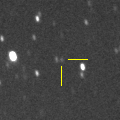
|
Now it is 18.0 mag (Feb. 12, Toshihiko Ikemura, Hirohisa Sato). It stays 18 mag from 2018 to 2020. It is observable in good condition in the Southern Hemisphere. It locates extremely low in the Northern Hemisphere.
Date(TT) R.A. (2000) Decl. Delta r Elong. m1 Best Time(A, h)
Mar. 17 12 57.41 -37 54.5 3.760 4.541 137 17.9 1:21 ( 0, 17)
Mar. 24 12 52.62 -38 10.7 3.710 4.536 141 17.9 0:49 ( 0, 17)
|

|
Now it is 18.7 mag (Jan. 20, Toshihiko Ikemura, Hirohisa Sato). It stays observable at 17.5 mag in good condition from spring to summer. However, Toshihiko Ikemura and Hirohisa Sato reported the comet was not detected, fainter than 19 mag, in February and March.
Date(TT) R.A. (2000) Decl. Delta r Elong. m1 Best Time(A, h)
Mar. 17 16 35.53 -9 13.2 3.479 3.888 107 18.0 4:44 (355, 46)
Mar. 24 16 37.12 -9 3.6 3.382 3.887 113 17.9 4:33 ( 0, 46)
|
|
![]()
 24P/Schaumasse
24P/Schaumasse C/2014 B1 ( Schwartz )
C/2014 B1 ( Schwartz ) C/2016 N4 ( MASTER )
C/2016 N4 ( MASTER ) 365P/2017 U6 ( PanSTARRS )
365P/2017 U6 ( PanSTARRS ) 2011 KE
2011 KE C/2010 U3 ( Boattini )
C/2010 U3 ( Boattini ) C/2014 OE4 ( PanSTARRS )
C/2014 OE4 ( PanSTARRS ) C/2017 D3 ( ATLAS )
C/2017 D3 ( ATLAS ) C/2018 A3 ( ATLAS )
C/2018 A3 ( ATLAS ) C/2018 E1 ( ATLAS )
C/2018 E1 ( ATLAS ) 143P/Kowal-Mrkos
143P/Kowal-Mrkos 30P/Reinmuth 1
30P/Reinmuth 1 21P/Giacobini-Zinner
21P/Giacobini-Zinner C/2017 E3 ( PanSTARRS )
C/2017 E3 ( PanSTARRS ) C/2014 R3 ( PanSTARRS )
C/2014 R3 ( PanSTARRS ) C/2015 XY1 ( Lemmon )
C/2015 XY1 ( Lemmon ) C/2016 T3 ( PanSTARRS )
C/2016 T3 ( PanSTARRS ) 186P/Garradd
186P/Garradd 187P/LINEAR
187P/LINEAR![]()




































